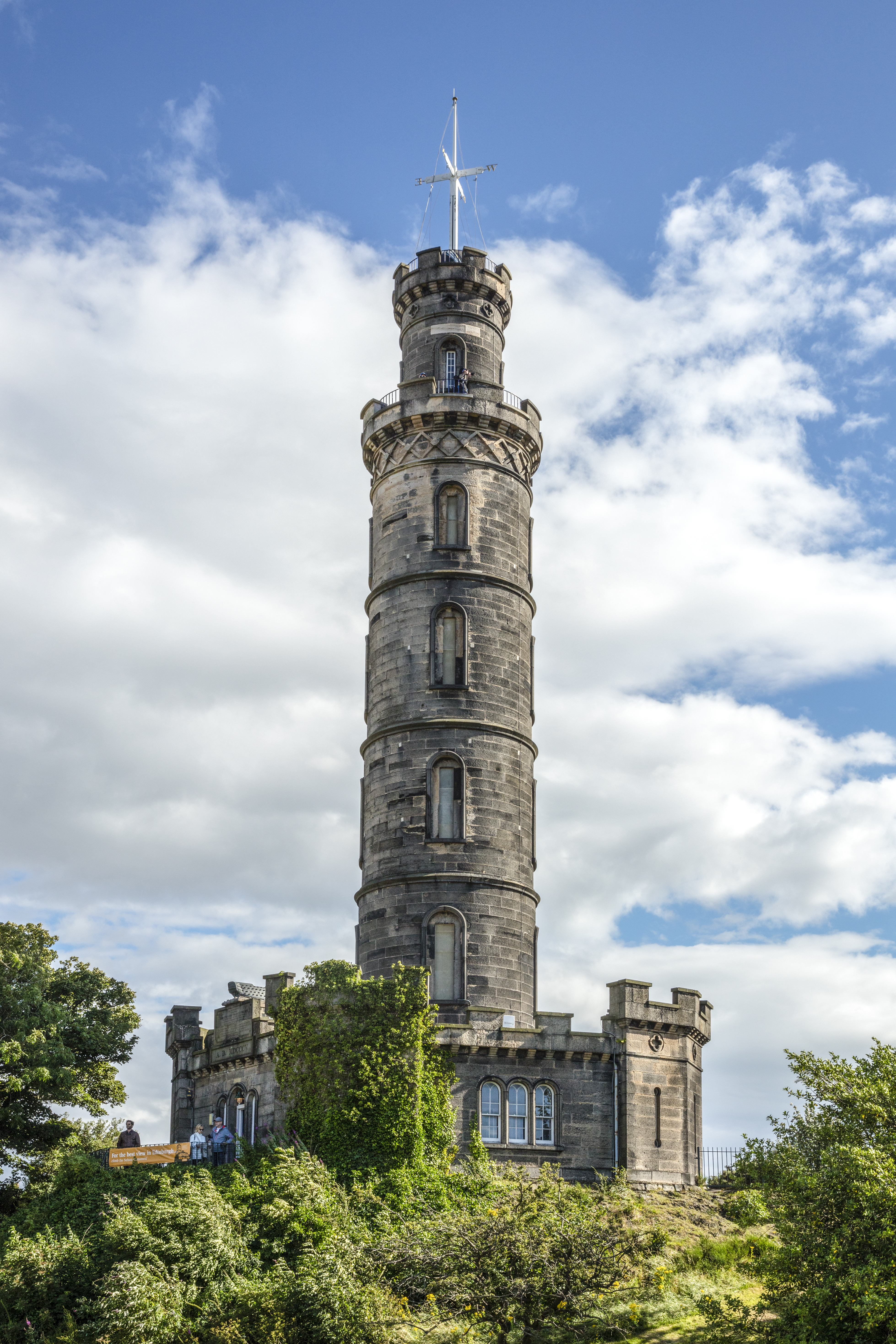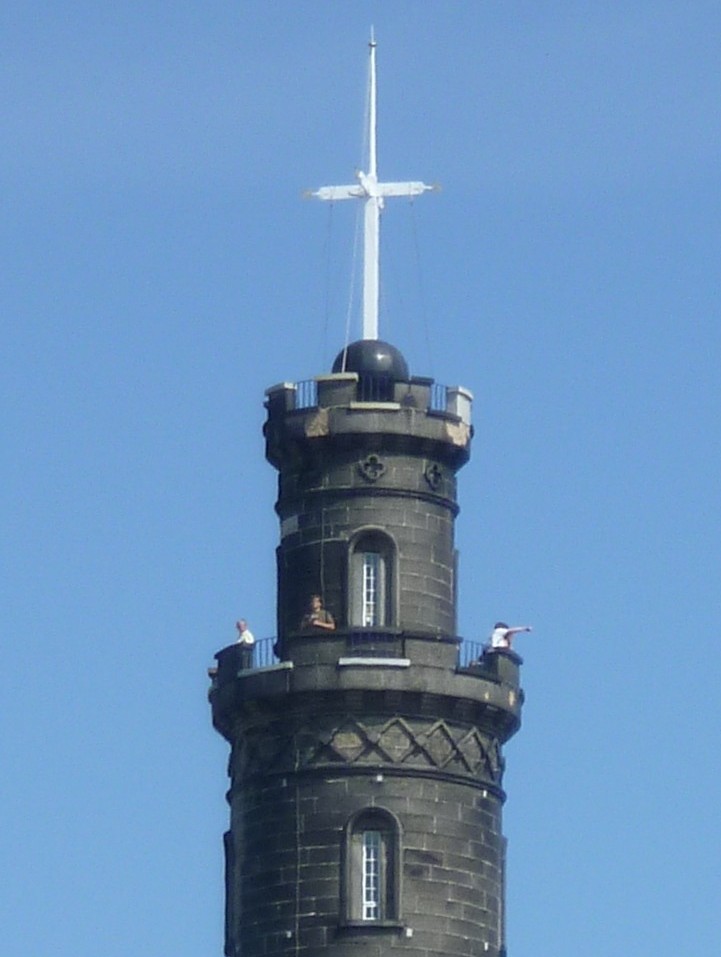Nelson Monument, Edinburgh on:
[Wikipedia]
[Google]
[Amazon]

 The Nelson Monument is a commemorative tower in honour of Vice Admiral Horatio Nelson, located in
The Nelson Monument is a commemorative tower in honour of Vice Admiral Horatio Nelson, located in
 On top of the tower is a
On top of the tower is a
Nelson Monument conservation
Edinburgh World Heritage {{Coord, 55, 57, 15.6, N, 3, 10, 57.3, W, type:landmark, display=title Monuments and memorials in Edinburgh Category A listed buildings in Edinburgh Tourist attractions in Edinburgh Monuments and memorials to Horatio Nelson Calton Hill Towers completed in 1815 1815 establishments in Scotland Time balls Observation towers in the United Kingdom

Edinburgh
Edinburgh ( ; gd, Dùn Èideann ) is the capital city of Scotland and one of its 32 council areas. Historically part of the county of Midlothian (interchangeably Edinburghshire before 1921), it is located in Lothian on the southern shore of t ...
, Scotland. It is situated on top of Calton Hill
Calton Hill () is a hill in central Edinburgh, Scotland, situated beyond the east end of Princes Street and included in the city's UNESCO World Heritage Site. Views of, and from, the hill are often used in photographs and paintings of the cit ...
, and provides a dramatic termination to the vista along Princes Street from the west. The monument
A monument is a type of structure that was explicitly created to commemorate a person or event, or which has become relevant to a social group as a part of their remembrance of historic times or cultural heritage, due to its artistic, hist ...
was built between 1807 and 1816 to commemorate Nelson's victory over the French and Spanish fleets at the Battle of Trafalgar
The Battle of Trafalgar (21 October 1805) was a naval engagement between the British Royal Navy and the combined fleets of the French and Spanish Navies during the War of the Third Coalition (August–December 1805) of the Napoleonic Wars (180 ...
in 1805, and his own death at the same battle. In 1852 a mechanized time ball
A time ball or timeball is a time-signalling device. It consists of a large, painted wooden or metal ball that is dropped at a predetermined time, principally to enable navigators aboard ships offshore to verify the setting of their marine chron ...
was added, as a time signal to shipping in Leith
Leith (; gd, Lìte) is a port area in the north of the city of Edinburgh, Scotland, founded at the mouth of the Water of Leith. In 2021, it was ranked by ''Time Out'' as one of the top five neighbourhoods to live in the world.
The earliest ...
harbour. The time ball is synchronized with the One O'Clock Gun
Edinburgh Castle is a historic castle in Edinburgh, Scotland. It stands on Castle Rock, which has been occupied by humans since at least the Iron Age, although the nature of the early settlement is unclear. There has been a royal castle on t ...
firing from Edinburgh Castle. The monument was restored in 2009.
The Royal Navy's White Ensign
The White Ensign, at one time called the St George's Ensign due to the simultaneous existence of a cross-less version of the flag, is an ensign worn on British Royal Navy ships and shore establishments. It consists of a red St George's Cross ...
and signal flags spelling out Nelson's famous message "England expects that every man will do his duty
"England expects that every man will do his duty" was a signal sent by Vice-Admiral of the Royal Navy Horatio Nelson, 1st Viscount Nelson from his flagship as the Battle of Trafalgar was about to commence on 21 October 1805.
During the batt ...
" are flown from the monument on Trafalgar Day
Trafalgar Day is the celebration of the victory won by the Royal Navy, commanded by Vice-Admiral Horatio Nelson, over the combined French and Spanish fleets at the Battle of Trafalgar on 21 October 1805.
History
The formation of the Navy Leag ...
each year.
History
The monument was constructed at the highest point of Calton Hill, at above sea-level, replacing an earlier mast used to send signals to shipping in the Forth. The monument was funded by public subscription and an initial design prepared byAlexander Nasmyth
Alexander is a male given name. The most prominent bearer of the name is Alexander the Great, the king of the Ancient Greek kingdom of Macedonia who created one of the largest empires in ancient history.
Variants listed here are Aleksandar, Al ...
. His pagoda-like design was deemed too expensive, and an alternative design in the form of an upturned telescope
A telescope is a device used to observe distant objects by their emission, absorption, or reflection of electromagnetic radiation. Originally meaning only an optical instrument using lenses, curved mirrors, or a combination of both to observ ...
—an object closely associated with Nelson—was obtained from the architect Robert Burn. Building began in 1807, and was almost complete when money ran out the following year. Burn died in 1815, and it was left to Thomas Bonnar to complete the pentagonal castellated
A battlement in defensive architecture, such as that of city walls or castles, comprises a parapet (i.e., a defensive low wall between chest-height and head-height), in which gaps or indentations, which are often rectangular, occur at interva ...
building, which forms the base to the tower, between 1814 and 1816.
The tower was intended as a signal mast, attended by sailors who would be accommodated within the ground floor rooms, although these were in use as a tea room by 1820. Public access was available from the start, for a small fee. The rooms were later used to house the monument's caretaker. In 2009, as part of the "Twelve Monuments Restoration Project", the tower was comprehensively restored, including repairs to stonework and metalwork. The monument is a category A listed building
In the United Kingdom, a listed building or listed structure is one that has been placed on one of the four statutory lists maintained by Historic England in England, Historic Environment Scotland in Scotland, in Wales, and the Northern Irel ...
.
The monument is high, and has 143 steps leading to a public viewing gallery. The castellated design reflects the castellated prison buildings which stood on the south side of Calton Hill in the early 19th century.
A plaque above the entrance to the monument carries the following dedication:
Above the plaque is a stone carving of the '' San Josef'', a ship captured by Nelson at the Battle of Cape St Vincent in 1797.
Time ball
time ball
A time ball or timeball is a time-signalling device. It consists of a large, painted wooden or metal ball that is dropped at a predetermined time, principally to enable navigators aboard ships offshore to verify the setting of their marine chron ...
, a large ball which is raised and lowered to mark the time. It was installed in 1853 and became operational in March 1854 to act as a time signal
A time signal is a visible, audible, mechanical, or electronic signal used as a reference to determine the time of day.
Church bells or voices announcing hours of prayer gave way to automatically operated chimes on public clocks; however, a ...
to the ships in Edinburgh's port of Leith
Leith (; gd, Lìte) is a port area in the north of the city of Edinburgh, Scotland, founded at the mouth of the Water of Leith. In 2021, it was ranked by ''Time Out'' as one of the top five neighbourhoods to live in the world.
The earliest ...
, and to ships at the anchorage in the Firth of Forth known as Leith Roads, allowing the ships to set their chronometers. The time ball was the idea of Charles Piazzi Smyth
Charles Piazzi Smyth (3 January 1819 – 21 February 1900) was an Italian-born British astronomer who was Astronomer Royal for Scotland from 1846 to 1888; he is known for many innovations in astronomy and, along with his wife Jessica Duncan P ...
, the Astronomer Royal for Scotland, and was originally triggered by a clock in the adjacent City Observatory, to which it was connected by an underground wire. The mechanism was the work of Maudslay, Sons & Field of Lambeth, who had previously constructed the time ball mechanism for Greenwich Observatory
The Royal Observatory, Greenwich (ROG; known as the Old Royal Observatory from 1957 to 1998, when the working Royal Greenwich Observatory, RGO, temporarily moved south from Greenwich to Herstmonceux) is an observatory situated on a hill in G ...
. The installation was carried out by James Ritchie & Son
James Ritchie & Son are a firm of Clockmakers in Broxburn, West Lothian, Scotland. The company was established in 1809 and is Scotland's oldest turret clock manufacturer.
The firm produces and maintains all sorts of clocks, including public cloc ...
who are still retained by City of Edinburgh Council to maintain and operate the time ball.
The ball, constructed of wood and covered in zinc
Zinc is a chemical element with the symbol Zn and atomic number 30. Zinc is a slightly brittle metal at room temperature and has a shiny-greyish appearance when oxidation is removed. It is the first element in group 12 (IIB) of the periodi ...
, and originally weighing about 90 kg, is raised just before 1 pm, and at precisely 1 pm, is dropped from atop the mast. The commonly stated mass of 15 cwt (762 kg) is a myth stemming from an exaggeration by Piazzi Smyth in 1853. Later, in 1861, the One O'Clock Gun
Edinburgh Castle is a historic castle in Edinburgh, Scotland. It stands on Castle Rock, which has been occupied by humans since at least the Iron Age, although the nature of the early settlement is unclear. There has been a royal castle on t ...
was established at Edinburgh Castle to provide an audible signal when fog obscured the time ball. The time ball was operated for over 150 years, until it was damaged by a storm in 2007. In 2009, as part of the restoration of the monument, the time ball was removed, and the mechanism repaired. The time ball was brought back into service on 24 September 2009. The mechanism is now operated manually, based on the firing of the One O'Clock Gun.
See also
* Monuments and memorials to Horatio Nelson, 1st Viscount Nelson, for other monuments to Lord NelsonReferences
External links
Nelson Monument conservation
Edinburgh World Heritage {{Coord, 55, 57, 15.6, N, 3, 10, 57.3, W, type:landmark, display=title Monuments and memorials in Edinburgh Category A listed buildings in Edinburgh Tourist attractions in Edinburgh Monuments and memorials to Horatio Nelson Calton Hill Towers completed in 1815 1815 establishments in Scotland Time balls Observation towers in the United Kingdom